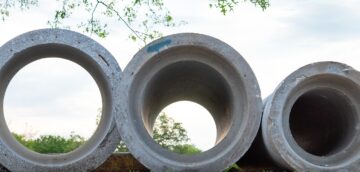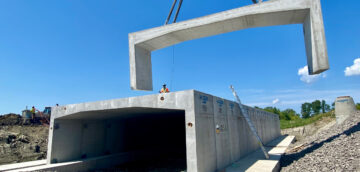When referring to sewers, sustainable infrastructure might get translated as the need for long-term pipe performance. For these underground pipelines, their ability to meet the desired design performance is highly dependent upon the support given to the pipe by way of its bedding and/ or embedment as constructed during installation. Sometimes, there is an implied confidence that a pipe will support any applied load (i.e. earth load, live load) without truly understanding the pipe, doing a pipe design, or achieving a proper installation.
Rigid Pipe
To install concrete pipe (rigid pipe), there are two options in Ontario: use of a Class ‘B’ bedding, or Class ‘C’ bedding. For concrete pipe, it is the bedding material which greatly influences the pipe’s ability to support loads. Figure 1 compares both bedding types, and details how they should appear in the field. A Class ‘B’ bedding provides the greatest support for a concrete pipe since the granular material beds the pipe up to springline (or half diameter). Alternatively, the Class ‘C’ bedding provides less support to the pipe. For a Class ‘C’ bedding, the pipe strength must be increased to offset the reduced pipe support given by this bedding.

Achieving these beddings during installation is critical since they contribute to a bedding factor that was first used to calculate the required strength of the concrete pipe. A designer using the Indirect Method for concrete pipe must choose an installation type (Trench or Embankment), as well as a bedding type (Class ‘B’ or ‘C’) before making a calculation of the required pipe strength. If the resulting pipe installation on site differs from design, the bedding factor could be significantly impacted such that a pipe is negatively compromised in the field. Acceptable granular materials can be referenced in OPSS 401, and construction guidelines in OPSD 802.
Of interest, there is an alternate installation method that is recognized in parts of Western Canada and also State-side which is called Standard Installations. This installation method is the result of a modern design theory for concrete pipe called Direct Design. Although not adopted for use in Ontario, years of research and practice have demonstrated this installation method to be effective. In 2001, the National Research Council Canada published a report “SIDD Pipe Bedding and Ontario Provincial Standards” which later prompted the four types of Standard Installation beddings to be adopted into the CHBDC under Section 7.8 “Reinforced Concrete Buried Structures”. Of the four bedding types to consider, SIDD Type 4 provides an option that minimizes cost by maximizing the effective use of in-situ materials. A Type 4 installation permits the placement of concrete pipe into an excavation with limited bedding preparation, limited material quality, and limited compaction efforts. SIDD Type 4 is an ideal installation for concrete pipe where long term settlement of the backfill is not a concern, but cost is a concern.
Lastly, all Standard Installations utilize a loosely placed, uncompacted bedding below the pipe invert which is known to effectively reduce stresses in the pipe.
Flexible Pipe
For flexible pipe, the requirements to install a thin wall plastic or steel pipe are much different – see Figure 2. At times there is a misconception about the strength of an installed flexible pipe. By theory, a flexible pipe’s stiffness contributes nearly 10% of the supporting strength of the installed pipe, while the surrounding soil embedment contributes nearly 90%. This makes installations of flexible pipe critically sensitive to the care taken by the contractor. When there is good contact of embedment material against the pipe perimeter, and proper compaction is achieved, only then is the pipe correctly supported for loading…and pipe deflection should be limited.

When comparing concrete and flexible pipes, there is one advantage that is overlooked: concrete pipe offers the potential to reduce imported granular materials. A designer has the option to use in-situ materials to cover and backfill a concrete pipe, if the materials prove acceptable. This is not the case for a flexible pipe of same diameter. A full embedment of granular to a minimum of 300mm above the top of flexible pipe is required. This can be a significant difference in material and labour costs when evaluating the overall cost of the installed pipeline. Furthermore, additional cost savings might be realized through a Life Cycle Cost Analysis (LCCA), or a LEED evaluation (not discussed here).
In summary, the ability of a buried pipeline to support any applied loads is not only reliant on the pipe, but more significantly on the quality of well placed and well compacted granular materials around the pipe. For concrete pipe, the bedding support below the pipe invert is critical; for flexible pipe, a full peripheral support by the embedment is critical.
As a designer, be sure you understand how a buried pipe supports the applied loads, for the implication of not knowing is risky.

The following internal Ministry of Transportation of Ontario (MTO) memorandum dated June 2009 explains why ...

Many underground infrastructure capital improvement projects are driven by capacity issues. The South Surrey Interceptorproject ...

A new development in Barrhaven, Ontario (just south of Ottawa) needed a bridge structure to ...
